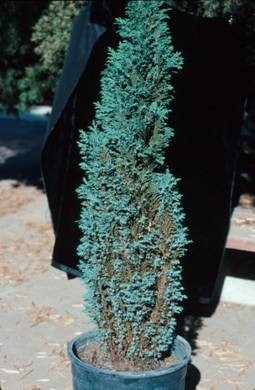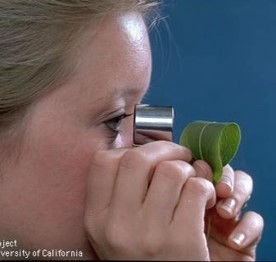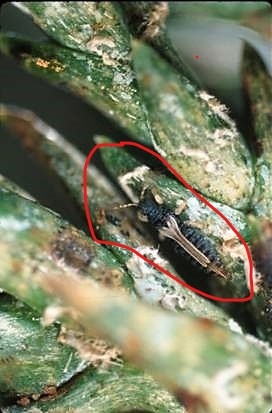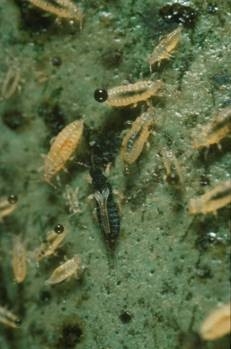As you walk quickly down the nursery walkway on the way to the sales team meeting, you glance over at the 1- gallon stock that's almost ready to sell. Then you stop; something is wrong with the Chamaecyparis lawsoniana. Yikes, the older portions of the branches are browning on many plants. So you take a closer look.
Left, what you might see quickly walking by. Looks pretty good!
Left, a closer look, without a hand lens. Something is wrong!
If you are like me, I've got my field hand lenses ready to pull out to take a closer look. I have got a 10 X and a 20 X (magnification) lens. The 10X is the most common magnification used in the field, and sufficient to help see and generally identify most of the common adult insect pests such as aphids, whiteflies, scales, mealybugs, fungus gnats and two-spotted spider mites.
When I see symptoms that appear to be caused by much smaller pests, such as eriophyid or broad mites, I'll pull out my 20X lens and take even a closer look. Sometimes I might see them. The 20 X lens has a very limited field of view, short depth of field, and is crazy hard to hold still. For these pests, and many other tiny immature insect life stages, it is best to take a sample back to the office or lab and use a stereo-microscope (binocular microscope), which works well at higher magnifications (20 X to 40X). But for me the 20X gives me a first look in the field, and may help pinpoint an infested sample to take back for the "scope".
You get the best view with a hand lens by holding it close to the eye. Use whatever hand and eye combination that seems comfortable. (Often right-handers use the right eye). You can keep glasses on if it works for you. Brace your lens holding hand on your cheek to stabilize it. Now with the other hand, move the specimen-- leaf, branch, stem-- to your lens until it is focused. With a 10X lens this will be about 1 inch away from the lens; with a 20X lens, about 1/2 inch away. With the subject in focus, position your body so that ambient light can illuminate the specimen. No hunching over the specimen like it is some big secret or something; let the light in.
Field hand lenses come in various forms and quality. "Hastings triplet" lenses have the best clarity, least distortion, and larger field of views than lower quality lenses. These high quality lenses are only about $35.
And back to the Chamaecyparis lawsoniana. What did the grower see associated with the necrotic branches when viewed with a field hand lens? Surprise, greenhouse thrips. Adults are black with pale wings. This slow-moving species lives in groups, unlike the solitary, fast-moving blackish predatory thrips. Larvae are white or yellow. At the tip of their abdomen they often carry a droplet of dark excrement. (Below. Adult circled in red on left image. Light colored larva and one adult on right image).
Don't forget to subscribe to the blog so that you receive an email notification when a new post goes up.




